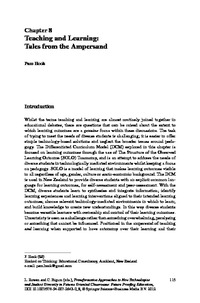Teaching and Learning: Tales from the AmpersandPam Hook
Zu finden in: Transformative Approaches to New Technologies and Student Diversity in Futures Oriented Classrooms (Seite 115 bis 137), 2012
 |
 |
 Diese Seite wurde seit 12 Jahren inhaltlich nicht mehr aktualisiert.
Unter Umständen ist sie nicht mehr aktuell.
Diese Seite wurde seit 12 Jahren inhaltlich nicht mehr aktualisiert.
Unter Umständen ist sie nicht mehr aktuell.
 Zusammenfassungen
Zusammenfassungen
 Focusing on the relationship between teaching and learning and being skeptical about claims often made about the ‘learning´ potential of new technologies, this paper explores the use of The Structure of the Observed Learning Outcome (SOLO) Taxonomy and the way it is used to address the needs of diverse students in technologically mediated environments. SOLO is a model of learning that makes learning outcomes visible to all regardless of age, gender, culture or socio-economic background. When used within the Differential Curriculum Model of New Zealand it is able to provide diverse students with an explicit common language for learning outcomes, for self-assessment and peer-assessment. Students learn to synthesise and integrate information; identify learning experiences and learning interventions aligned to their intended learning outcomes; choose relevant technology-mediated environments in which to learn; and build knowledge to create new understandings. In this way diverse students become versatile learners with ownership and control of their learning outcomes, ready to live well with others in whatever contexts their futures might offer.
Focusing on the relationship between teaching and learning and being skeptical about claims often made about the ‘learning´ potential of new technologies, this paper explores the use of The Structure of the Observed Learning Outcome (SOLO) Taxonomy and the way it is used to address the needs of diverse students in technologically mediated environments. SOLO is a model of learning that makes learning outcomes visible to all regardless of age, gender, culture or socio-economic background. When used within the Differential Curriculum Model of New Zealand it is able to provide diverse students with an explicit common language for learning outcomes, for self-assessment and peer-assessment. Students learn to synthesise and integrate information; identify learning experiences and learning interventions aligned to their intended learning outcomes; choose relevant technology-mediated environments in which to learn; and build knowledge to create new understandings. In this way diverse students become versatile learners with ownership and control of their learning outcomes, ready to live well with others in whatever contexts their futures might offer. Dieses Kapitel erwähnt ...
Dieses Kapitel erwähnt ...
 Anderswo finden
Anderswo finden
 Volltext dieses Dokuments
Volltext dieses Dokuments
 |  Teaching and Learning: Tales from the Ampersand: Artikel als Volltext bei Springerlink ( Teaching and Learning: Tales from the Ampersand: Artikel als Volltext bei Springerlink ( : :  , 923 kByte; , 923 kByte;  : :  2020-11-28) 2020-11-28) |
 Anderswo suchen
Anderswo suchen 
 Beat und dieses Kapitel
Beat und dieses Kapitel
Beat hat Dieses Kapitel während seiner Zeit am Institut für Medien und Schule (IMS) ins Biblionetz aufgenommen. Er hat Dieses Kapitel einmalig erfasst und bisher nicht mehr bearbeitet. Beat besitzt kein physisches, aber ein digitales Exemplar. Eine digitale Version ist auf dem Internet verfügbar (s.o.). Aufgrund der wenigen Einträge im Biblionetz scheint er es nicht wirklich gelesen zu haben. Es gibt bisher auch nur wenige Objekte im Biblionetz, die dieses Werk zitieren.











 Biblionetz-History
Biblionetz-History